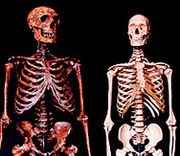Buia Man
Hominid Scull reveals unusual characteristics:
The skull, being called "Buia Man" is the most complete hominid skull from the time range of 600,000 to 1.4 million years ago. That alone is remarkable, but the skull structure is even more so. There are characteristics of both Homo erectus and Homo sapiens.
Buia Man thus is the oldest known appearance of a hominid with Homo sapiens characteristics. The characteristics of Homo erectus in the skull are massive brow ridges and elongated skull as well as smaller brain capacity. The Homo sapiens characteristic is the placement and size of the parietal bones. "The age of the skull indicates that morphology like that of Homo sapiens had begun to differentiate in Africa 1 million years ago, which is 300,000 years earlier than previously estimated."
© Discover Magazine September 1998, Breakthroughs: Human Origins, page 26.
More on the Buia Man...
A Million-Year Old Relative
 September 1, 1998 -- When a 30-year war between Ethiopia and Eritrea came to an end in 1991, it brought not just peace and independence for the people of Eritrea but a chance for geologist
September 1, 1998 -- When a 30-year war between Ethiopia and Eritrea came to an end in 1991, it brought not just peace and independence for the people of Eritrea but a chance for geologist
Ernesto Abbate of the University of Florence to resume his long-suspended excavations in the region. That exploration has now paid off. Abbate recently discovered a 1-million-year-old hominid skull near the village of Buia in Eritrea, not far from the Red Sea coast.
The fossil, found with two teeth and fragments of a pelvis, is the first intact hominid skull found from the period between 1.4 million and 600,000 years ago. But even more remarkable is the skull's shape. It blends features of Homo erectus-a tool-using hominid predating modern humans-with those of Homo sapiens. The find, which Abbate calls Buia man, although the sex of the individual is not known, marks the earliest known appearance of an individual with Homo sapiens traits.
The skull is long and oval, pointed at the back, and has massive browridges, all features characteristic of Homo erectus, as is the small brain capacity. Where the skull differs from erectus is in the parietal bones, which form the curved sides and top of the skull. They are much wider at the top than those of H. erectus and are typical of Homo sapiens.
Found in the same sediments as the skull were the bones of elephants, rhinoceroses, hippopotamuses, and primitive pigs. These fossils, says Abbate, provide hints to the hominid's habits and the environment in which it lived. "It was a savanna with wide green spaces, streams, ponds, and lakes. Quite different from the harsh present day," he says. "The artifacts that we found seem to suggest that the Buia man could hunt and slaughter animals."
But most interesting of all to Abbate is what the skull tells us of our own evolution. Prior to this find, the earliest fossils with H. sapiens features date to a mere 700,000 to 600,000 years ago. "The age of this skull indicates that morphology like that of Homo sapiens had begun to differentiate in Africa 1 million years ago," says Abbate, "which is 300,000 years earlier than previously estimated."
http://discovermagazine.com/1998/sep/amillionyearoldr1513
Back to What's New?
Back to Newspaper & Magazine Articles
Home/Main
Portions of this website are reprinted under the
Fair Use Doctrine
of International Copyright Law as educational material without benefit of financial gain.
This proviso is applicable throughout the entire website at www.bigfootencounters.com